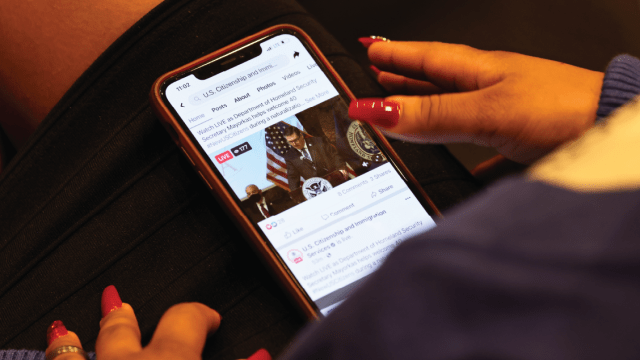
The Pew-Knight Initiative supports new research on how Americans absorb civic information, form beliefs and identities, and engage in their communities.
Pew Research Center is a nonpartisan, nonadvocacy fact tank that informs the public about the issues, attitudes and trends shaping the world. Knight Foundation is a social investor committed to supporting informed and engaged communities. Learn more >
Pew Research Center conducted this study to understand how TikTok users, X (formerly Twitter) users, Instagram users and Facebook users experience news on these platforms. For this analysis, we surveyed 10,287 adult internet users in the United States from March 18 to 24, 2024.
Everyone who took part in the survey is a member of the Center’s American Trends Panel (ATP), an online survey panel that is recruited through national, random sampling of residential addresses. This way, nearly all U.S. adults have a chance of selection. The survey was weighted by combining the sample of internet users with data from ATP members who do not use the internet, and weighting the combined dataset to be representative of all U.S. adults by gender, race, ethnicity, partisan affiliation, education and other categories. The analysis in this report is based on those who use the platforms of interest. For more about how this was done, refer to the survey methodology. Read more about the ATP’s methodology.
Here are the questions used for this report, along with responses, and the survey methodology.
This is a Pew Research Center report from the Pew-Knight Initiative, a research program funded jointly by The Pew Charitable Trusts and the John S. and James L. Knight Foundation. Find related reports online at https://www.pewresearch.org/pew-knight/.
Social media platforms are an important part of the American news diet: Half of U.S. adults say they get news at least sometimes from social media in general. But specific platforms differ widely in structure, content and culture. A new Pew Research Center survey finds that the ways in which Americans encounter news on four major platforms – TikTok, X, Facebook and Instagram – vary widely.
Key findings from this study include:
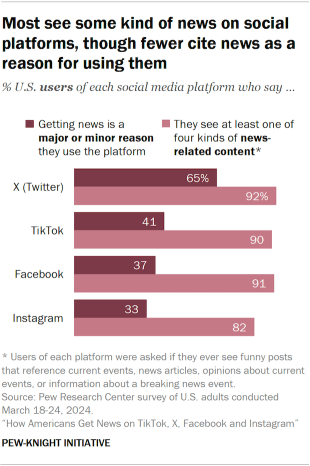
- Majorities of Facebook, Instagram and TikTok users say keeping up with news is not a reason they use the sites. X (formerly Twitter) is the exception to this pattern: Most X users say that keeping up with news is either a major or minor reason they use the platform, and about half say they regularly get news there.
- Still, people are seeing news on all four platforms, especially through opinion- or humor-based content. Majorities of users on all four sites say they see people expressing opinions about current events and funny posts that reference current events. On the whole, more people see these types of posts than news articles or breaking news, although many also see that type of content (particularly on X and Facebook).
- News on each platform comes from a variety of sources. Those who regularly get news on Facebook and Instagram are more likely than those on TikTok and X to get news from friends, family and acquaintances. More news consumers get news from influencers or other people they don’t know personally on TikTok than on other platforms. And news outlets or journalists are a more common source of news on X than on any other site.
- Most news consumers on each of the platforms studied say they at least sometimes see news on the platform that seems inaccurate. This includes roughly a quarter or more on each site who say they extremely or fairly often see inaccurate news.
- In general, Democrats tend to be more skeptical than Republicans of the news they see on X, while the reverse is true on Facebook. Among those who regularly get news on X, for example, 42% of Democrats and independents who lean toward the Democratic Party say they often see news there that seems inaccurate, compared with 31% of Republicans and GOP leaners.
More about this project
This project was designed to understand how people’s experiences and views differ across social media sites and apps.
The survey covered four social media platforms: TikTok, X (formerly Twitter), Facebook and Instagram. Each platform’s questions were identical.
This report focuses on news on social media. To learn about how people engage with politics on these platforms, read the companion report.
These are some of the key findings from a new Pew Research Center survey of about 10,000 U.S. adults conducted in March 2024. This is one of two Pew Research Center reports on habits and attitudes on different social media platforms from the Pew-Knight Initiative, a research program funded jointly by The Pew Charitable Trusts and the John S. and James L. Knight Foundation.
The rest of this overview looks at these patterns and other comparisons of the four platforms in more detail. For a closer look at individual platforms, jump to chapters on TikTok, X (formerly Twitter), Facebook and Instagram.
Aside from X, most users on each platform don’t regularly get news there, but large majorities encounter news in some form
News consumption is more common on some sites than others. A 2023 Pew Research Center survey found that Facebook outpaces all other social media sites as a news source for Americans, with 30% of U.S. adults saying they regularly get news there. Smaller shares regularly get news on Instagram (16%), TikTok (14%) or X (12%).
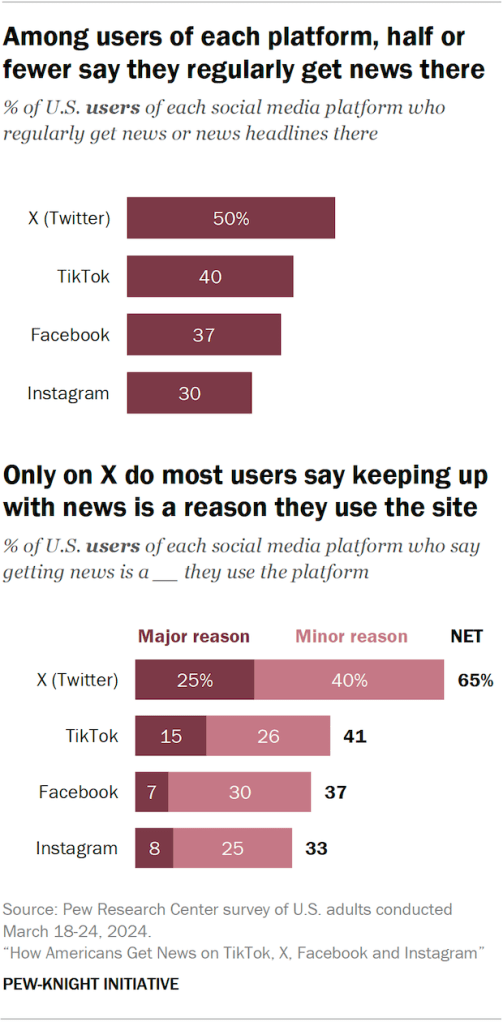
Some sites are more widely used in general than others. But there also are differences among users in the share who say they regularly get news on each site. According to a new Center survey, half of X users say they regularly get news there, compared with smaller shares on TikTok (40%), Facebook (37%) and Instagram (30%).
The new survey also asked users of each platform whether keeping up with the news is a major or minor reason they use the platform – or not a reason at all. X is the only platform on which a majority of users say that getting news is a reason they use it: Roughly two-thirds of X users (65%) say this is the case, including 25% who say keeping up with the news is a major reason they use X.
Fewer than half of TikTok, Facebook and Instagram users say that getting news is a major or minor reason they use the site. And just 15% of TikTok users, 7% of Facebook users and 8% of Instagram users say it’s a major reason.
People more frequently cite other reasons for using each platform. To read more about other reasons given for using each platform, read “How Americans Navigate Politics on TikTok, X, Facebook & Instagram.”
While a relatively small portion of users on these platforms say that getting news is a major reason they use them, far more on all platforms say they see news-related content there.
Opinions and humorous content related to news are common on all four platforms. Two-thirds or more of users on each site say they ever see people expressing opinions about current events or funny posts that reference current events. On Facebook, Instagram and TikTok, users are less likely to say they ever see news articles (whether posted, reposted, linked or screenshotted) or information about a breaking news event as it is happening. X is the only platform studied where at least three-quarters of users see all of these types of information.
Considering the four different types of news-related content asked about, a large majority of users on all the platforms say they ever see at least one of them. About eight-in-ten Instagram users see at least one of these types of news-related content (82%), as do 90% of TikTok users, 91% of Facebook users and 92% of X users.
X stands out as a place to see breaking news: 75% of users say they see information about breaking news in real time there, compared with smaller shares of users on Facebook (58%), TikTok (55%) and Instagram (44%).
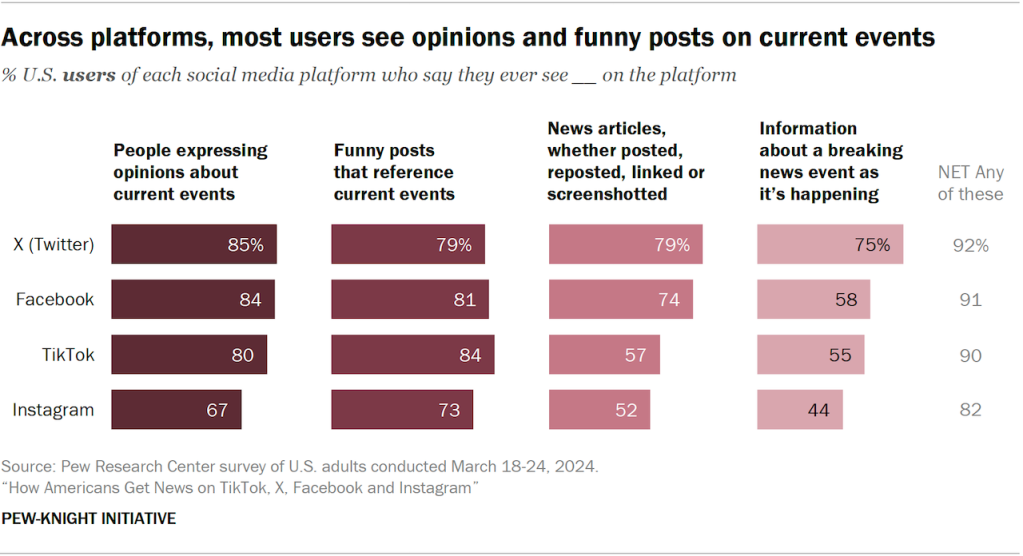
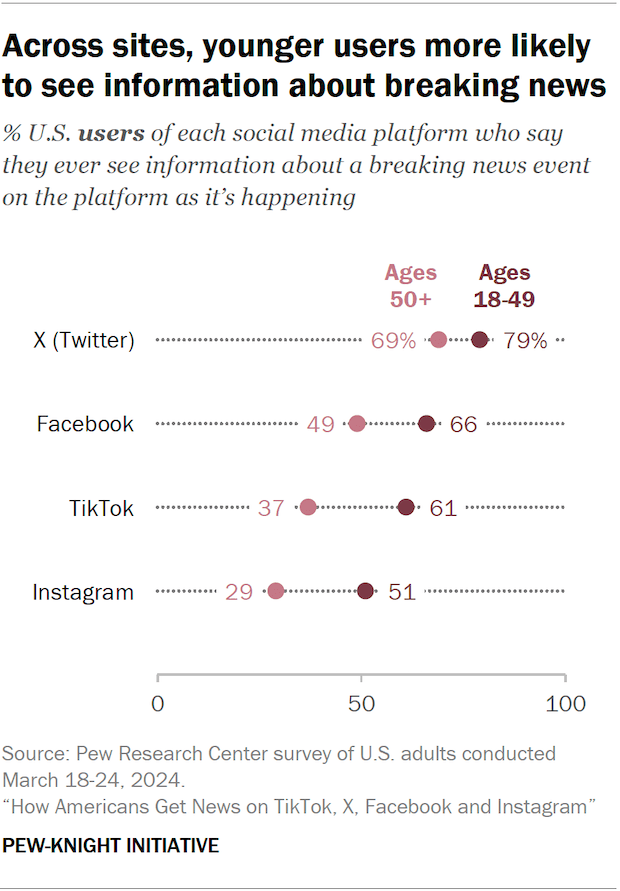
X and Facebook users are the most likely to see news articles on each platform, with 79% of X users and 74% of Facebook users saying they do. Americans who use TikTok (57%) and Instagram (52%) are less likely to report seeing news articles.
Across sites, younger users are much more likely to see information about breaking news. On Instagram, for example, about half of users under 50 say they see breaking news about events as they’re happening (51%), compared with 29% of those 50 and older. And on X, where majorities of both age groups see breaking news on the platform, younger users are still more likely to than older users to see this (79% of users under 50 vs. 69% of those 50 and older).
What types of sources are Americans getting news from on social media sites?
Many questions on this survey were asked only of users who say they regularly get news on each site. The remainder of this overview looks through this lens to compare the experiences and opinions of these news consumers on TikTok, X, Facebook and Instagram.
Among those who regularly get news on each platform – also described as “news consumers” – the types of sources they get that news from differ from platform to platform.
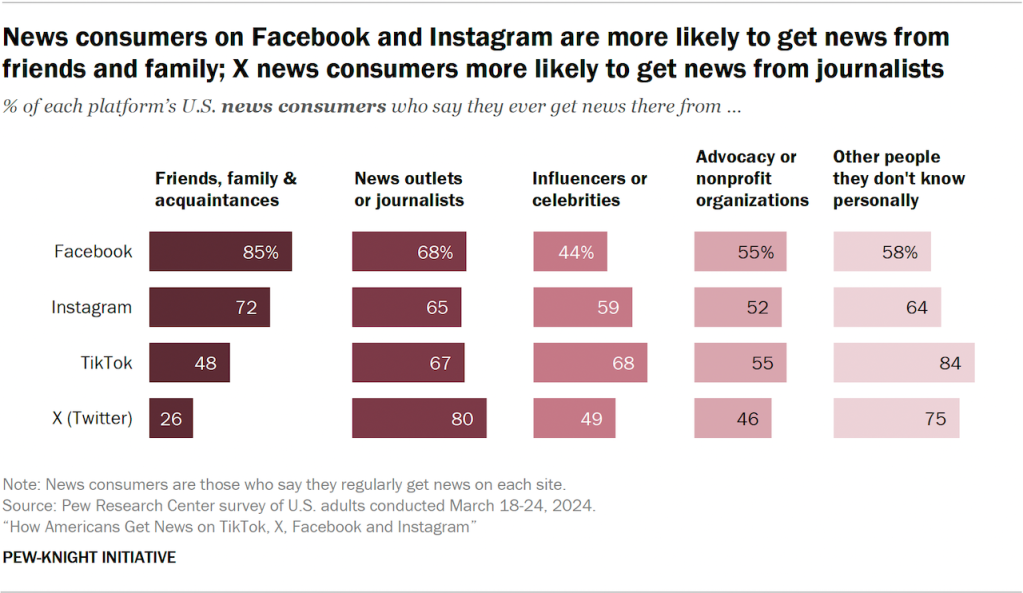
Facebook news consumers are the most likely to say they’ve ever gotten news there from friends, family and acquaintances (85%). Most Instagram news consumers (72%) also say they have done this; friends and family are the most common news source for news consumers on both Facebook and Instagram. Americans who say they regularly get news on TikTok (48%) and X (26%) are much less likely to say they have gotten news there from friends, family and acquaintances. This is by far the least common source of information for X news consumers among the types of sources measured in the survey.
Majorities of news consumers report getting news from news outlets or journalists on all four sites. X news consumers are the most likely to say this (80%), compared with about two-thirds of news consumers on Facebook (68%), TikTok (67%) and Instagram (65%) who say the same.
TikTok news consumers are more likely than those on other platforms to say they get news from influencers and celebrities, with about two-thirds (68%) saying they ever do this. A majority of those who regularly get news on Instagram (59%) say the same.
There are only modest differences across the platforms in the share who get news from advocacy or nonprofit organizations: Around half on each site say they do.
While over half of news consumers on all four sites say they ever get news from other people they don’t know personally (beyond those previously mentioned), those on TikTok (84%) and X (75%) are especially likely to say this. For TikTok news consumers, these types of accounts are the most common news source.
Some of these sources are more likely to be used by different groups regardless of what platform they are using. For example, Democratic news consumers on most sites are more likely than their Republican counterparts to get news from advocacy or nonprofit organizations.
Republicans more skeptical of information on Facebook, Democrats more skeptical toward X
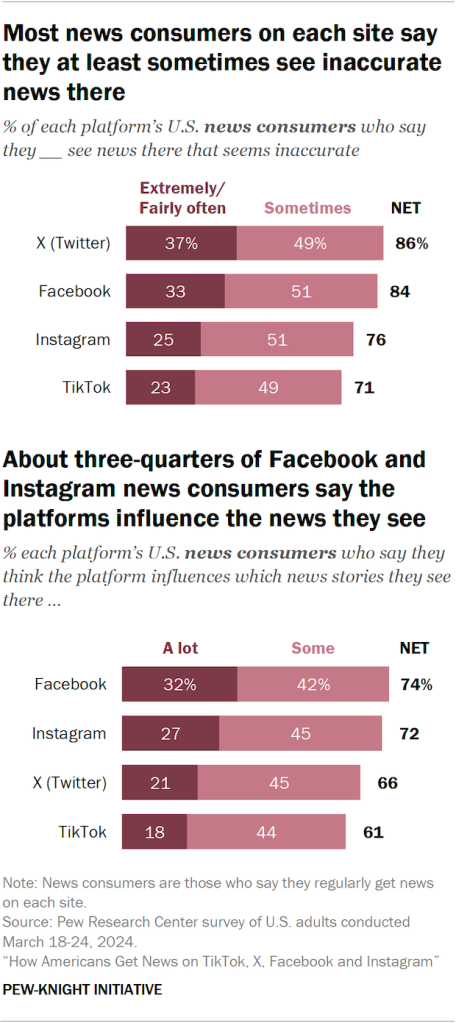
Amid broader concerns about the accuracy of information on social media, most news consumers on each of the four major social media platforms studied say they at least sometimes see news on the platform that seems inaccurate. This includes roughly a quarter or more on each site who say they extremely or fairly often see inaccurate news.
News consumers on X (37%) and Facebook (33%) are the most likely to say they often see news that seems inaccurate.
Americans also largely see social media platforms as influencing which news stories they see there to at least some extent.
About three-quarters of news consumers on Facebook (74%) and Instagram (72%) – both owned by Meta – say the platforms influence which news stories they see there at least some, including roughly three-in-ten who say the platforms have a lot of influence. On these sites, news consumers with a higher level of educational attainment are more likely to say the platforms influence which news stories they see.
Roughly two-thirds of X news consumers (66%) and 61% of TikTok news consumers say the sites influence what they are seeing at least somewhat.
Although users maintain some level of control by deciding whom they follow on each site, computer algorithms also impact users’ feeds on many social media platforms, and technology companies have a variety of policies on how they moderate content such as false information and violent imagery. Some sites allow users to modify their settings, though previous Center research has found that very few Americans feel like they have a lot of control over what they see online.
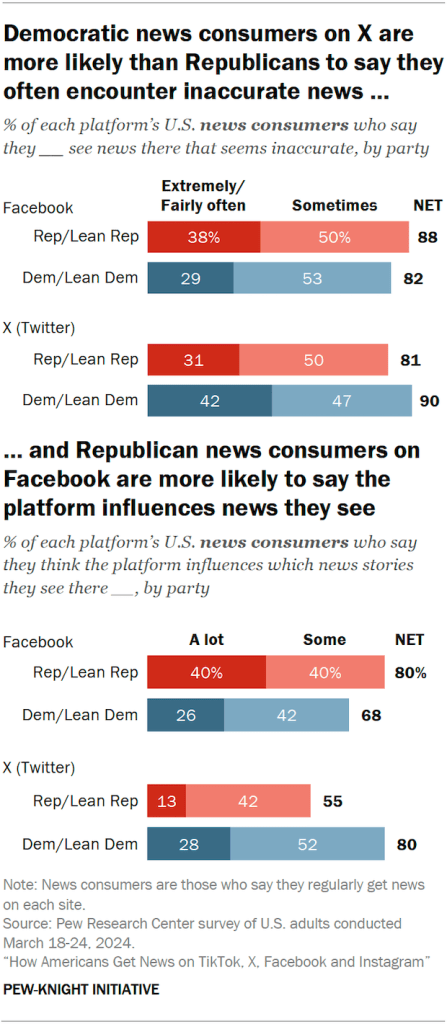
There are notable party divides in views toward the information on some platforms. Democrats who get news on X (including those who lean Democratic) are more likely than their Republican and GOP-leaning counterparts to say they extremely or fairly often see inaccurate news there (42% vs. 31%).
Democratic news consumers on X also are far more likely than their Republican counterparts to say X influences which news stories they see at least some (80% vs. 55%).
On Facebook, the reverse is true, with 38% of Republican Facebook news consumers saying they often see inaccurate news, compared with 29% of Democratic Facebook news consumers. Republican news consumers on Facebook also are more likely than Democratic news consumers on the site to say they think Facebook influences which news stories they see there at least some (80% vs. 68%).
There is little to no partisan difference in views toward Instagram and TikTok by these two measures.
How unique is the news seen on social media sites?
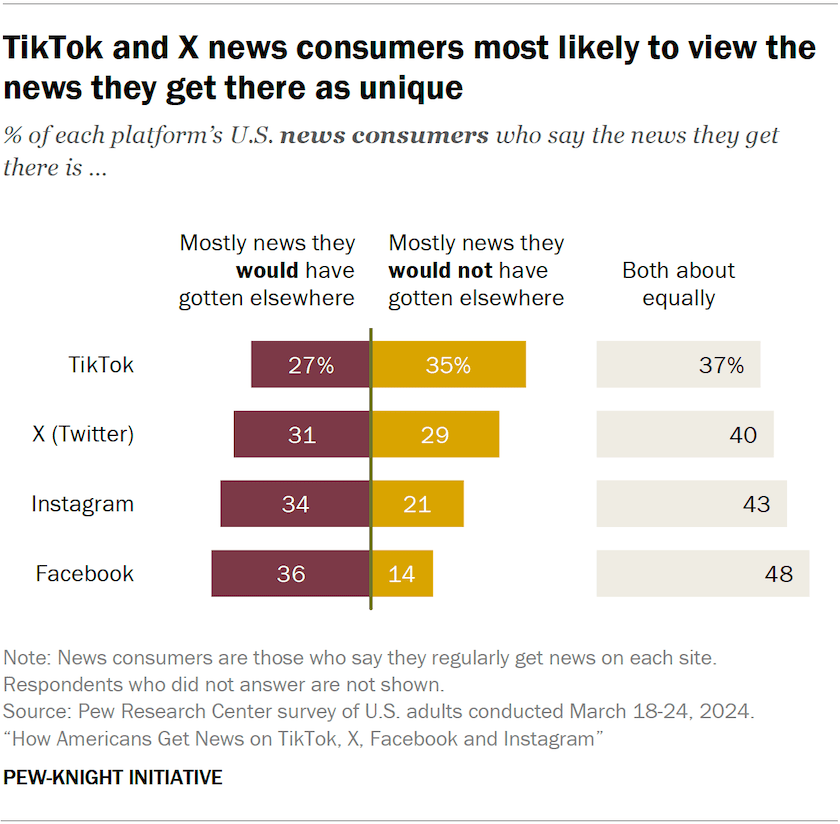
The survey asked Americans who say they regularly get news on each site whether they think the news they get there is mostly news they would have gotten elsewhere, or whether it’s news they only would have found on that site.
News consumers on TikTok (35%) and X (29%) are the most likely to say that the news they get on those sites is unique – i.e., news they would not have seen elsewhere.
Smaller shares of news consumers on Instagram (21%) and Facebook (14%) hold this view. It’s more common for Instagram and Facebook news consumers to say that the news they see is mostly news they would have gotten elsewhere (34% and 36%, respectively).
On each of the four sites, about four-in-ten or more news consumers say that the news they see is an even mix of news they would have gotten elsewhere and news they would not have gotten elsewhere.
Most news consumers on Facebook, X and Instagram at least sometimes feel worn out by the news they see
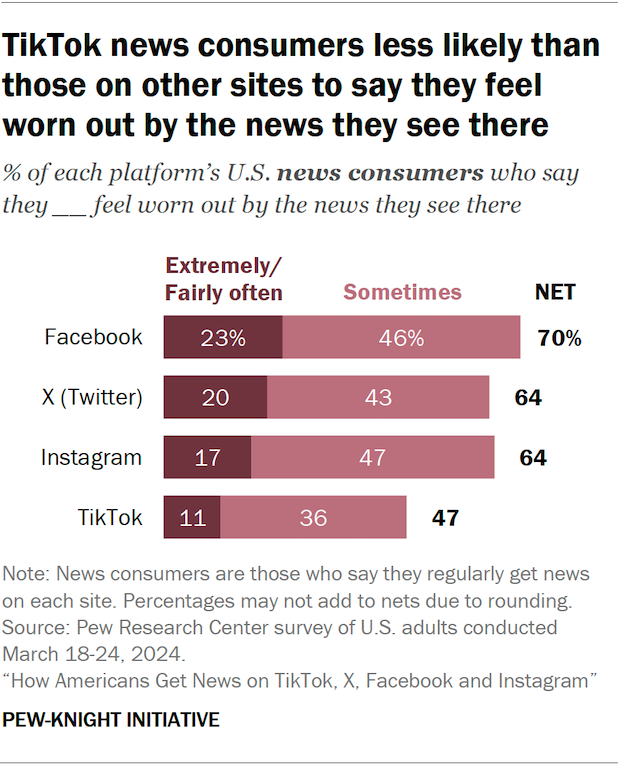
More than half of news consumers on three of the four sites studied at least sometimes feel worn out by the amount of news they see on these sites. This includes roughly one-in-five news consumers on Facebook (23%), X (20%) and Instagram (17%) who say they extremely or fairly often feel this way.
TikTok news consumers are somewhat less likely to often (11%) or sometimes (36%) feel worn out by the news they see on TikTok.
Democrats who regularly get news on X report often feeling worn out by the news there at a much higher rate than Republican news consumers on the platform (31% vs. 11%).




